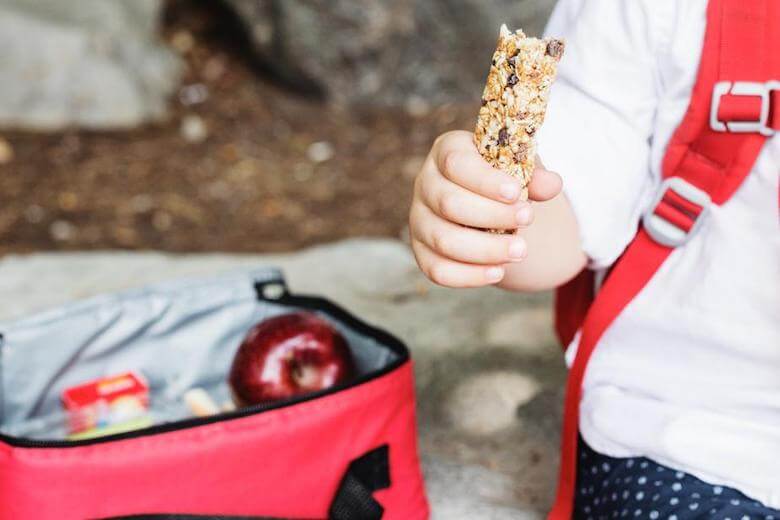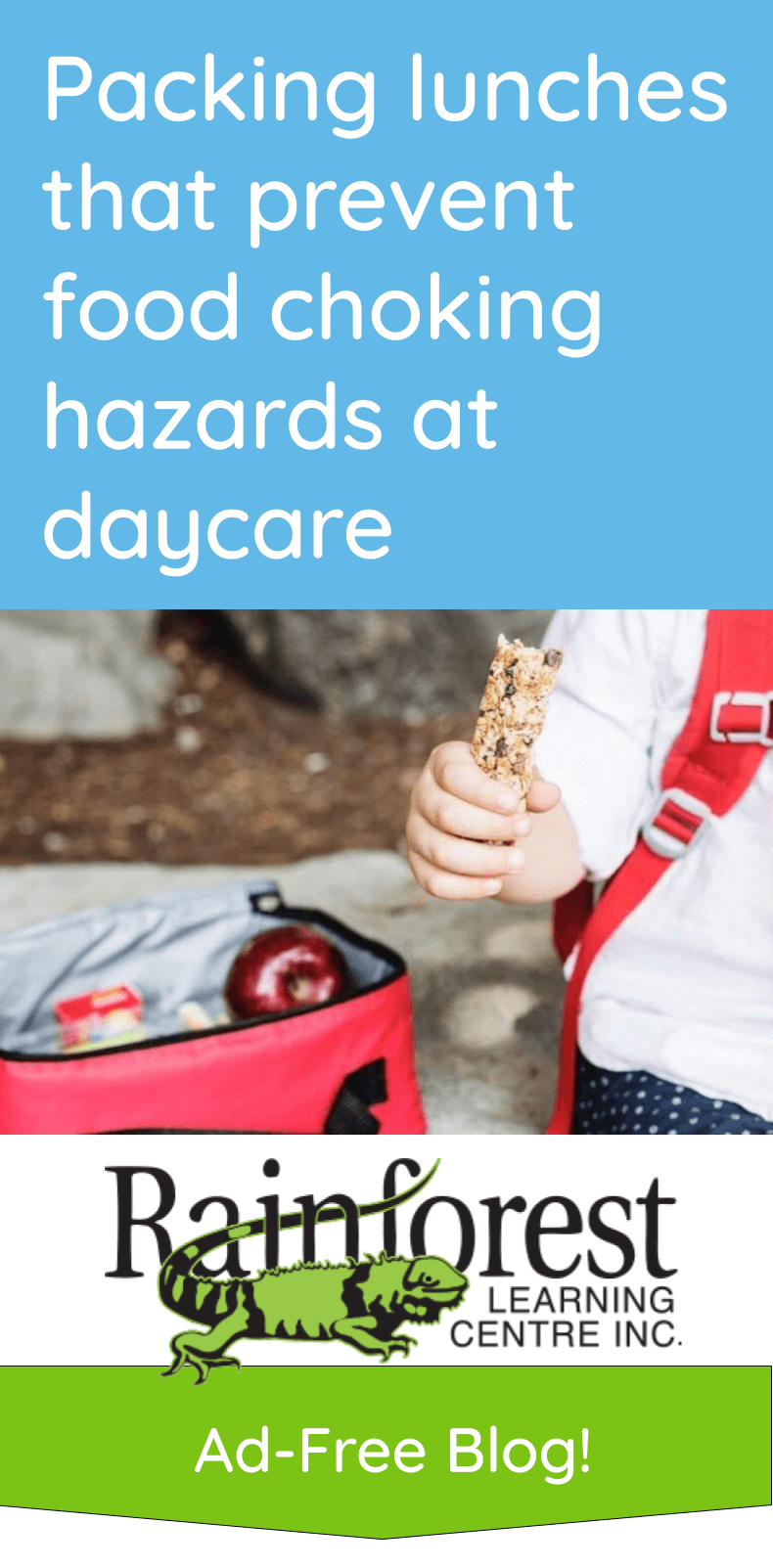
When your child goes to daycare, you may be asked to pack a lunch for them. Whether they eat alone, or they share food in groups, it’s important to ensure that parents are taking their part to prevent food choking hazards at daycare.
The statistics of food-related choking are heartbreaking. These things do happen. So being aware of these food dangers, and avoiding them, is the first step to keeping a daycare centre free of choking hazards.
In this article, we’ll go over some of the foods that can cause choking in toddlers and children, and the ways we can prevent choking from happening.
Even if your child wouldn’t choke on foods you pack for lunch, other kids may
You may feel completely safe sending your toddler or child to daycare with foods they commonly eat. These may be large, chunky foods, like apple slices, nuts or hot dog pieces.
Sometimes, slightly older kids who have no problem with these foods may simply be in a daycare classroom with much younger toddlers and infants. These younger ones may not have the right teeth or development for chewing yet. And even similarly-aged kids can develop differently, or be used to different types of food.
The problem here may be that children exchange foods without adults noticing. Plus, there’s no telling if a child may somehow get their hands on the wrong lunch pack.
So, the foods you pack for your child’s lunch can be a risk to others.
Of course, childcare workers are there to supervise as much as they can. However, when it comes to prevention, parents should always be willing to help make the job of these caregivers as easy as possible.
Before you pack your own child’s lunch for daycare, consider what may be a choking hazard – either to them when no one is looking, or to other kids in the classroom.
Be aware of the common food choking hazards with toddlers – some may surprise you
When we think of choking in toddlers, we often think of small toys or candies they put in their mouth. However, asphyxiation in children can happen with the so-called ‘normal’ foods we give them, and that we may not suspect as being a choking hazard.
Toddlers and young children can choke on any food, technically speaking. However, some foods are a bigger choking hazard than others, for young ones. For example, did you know that a child died from choking on a hot dog? Ice and popsicles can also break off in large pieces, and then get lodged in the throat. They won’t melt fast enough, and can choke a child. Whole grapes are also dangerous. Also, peanut butter and sticky foods can block airways, and get stuck to the mouths of toddlers. Popcorn can have kernels that can be a choking hazard too.
So when you think about it, it’s not just hard foods that can choke children – like nuts. It happens with slippery foods, and foods they can easily bite too much of, if you are allowing them to do so. Meat, fruit, vegetables – if these are too big, they can choke a child.
Here is a list of common food choking hazards for young children:
- Hot dogs
- Carrot sticks and other raw vegetables
- Cheese and meats (especially in large chunks)
- Popcorn
- Nuts and seeds
- Peanut butter
- Ice cubes
- Whole grapes
- Orange and apples slices (especially with their skin)
- Gum, hard and soft candy, raisins, etc.
Know how to prevent food choking hazards at daycare by packing a safe lunch for kids
Thankfully, there are some easy ways to pack safe lunches that reduce the risks of choking in toddlers at daycare. Below we’ll give some ideas (though you should always test these with your own kids before sending them to daycare with something new!)
- Cut foods into smaller pieces – smaller than ‘bite sized,’ even. With hot dogs and sausages, for example, cut them into halves and quarters. Same goes for grapes or strawberries.
- Remove skins, seeds and pits from fruits, and cut them up too. Don’t send an entire apple with your child to daycare, for instance. Peel and cut it up first.
- Try mashing foods. Mashed foods can actually be tasty for toddlers. Think: applesauce. Though, you can also mash fruits and some veggies. At room temperature, these are not so bad tasting either (like potato salad).
- Steam or cook vegetables to make them softer. With carrots, for example, if they are softer, they can be much easier to chew, and to bite.
- Pack foods that are already soft and easy to swallow. For example, untoasted bread that is cut up into child-size pieces, with jam spread. Or yogurt and jello.
We would say that you can spread peanut butter thinly on bread or crackers. However, since peanuts are a common allergy, it’s best to avoid packing these for a daycare snack. If your child is not allergic, you can certainly enjoy nuts at home!
Meats (like cold cuts) and cheeses can go bad easily. So, if you do pack them for your child’s lunches, even if they are prepped for choking safety, just be sure they are in an insulated bag with an ice pack. Or, that they can go in a refrigerator at daycare. Of course, it goes without saying that you should remove all bones from meats first.
Make sure your daycare practices safe, supervised eating
Apart from packing safe lunches for children, daycare centres should also be practicing safe eating habits. In short, that means:
- Instructing kids to eat upright at a table, as a focused activity. If kids are playing and eating at the same time, that can also be a choking hazard. Making sure that eating is happening while sitting still, and upright, is best. This also allows the childcare workers to supervise eating much more easily.
- Teaching kids to chew thoroughly, and not rush their eating. This is something that should be taught at home. But daycare centres can also help teach kids to slow down in this regard.
- Ensuring children are supervised while eating. During a snack or lunchtime activity, young children should not be left alone while eating. Professional daycare centres would not do this. There will usually be at least two on staff for these scenarios. At least one should be present while children are eating.
- Training staff with first-aid skills. Child caregivers should have the first-aid qualifications for their job. They should know what to do if a child is choking. Whether that means Heimlich Maneuver, or back strokes, or calling 9-1-1, they should be prepared.
In addition, daycare centres may also want to teach children about food allergies, to prevent them from being a hazard. And, learning about food contamination and cleanliness habits can also keep the daycare food safe!
To conclude: preventing food choking hazards at daycare is everyone’s responsibility
Parents whose kids go to daycare may be short on time. But safety is always number one. Making sure your child gets a packed lunch that is free of choking hazards keeps the whole daycare centre safe. Knowing which foods are the most serious to avoid is helpful. Coming up with ideas for snacks and lunches, and sharing them with parents, is also a good idea. Keep these types of lists handy, and also teach your children about them. Maybe they’ll learn to be extra careful with their food too!
See more on our blog:
